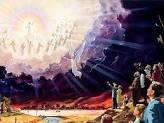
The Book of Daniel is one of the most interesting in the Old Testament. Part of it consists of stories with underlying messages and part is apocalyptic writing. "Apocalypse" means revelation or disclosure. The book was probably written in the reign of the tyrant Antiochus Ephinanes, in about the second century BC. It was a time of great suffering for the Jews, as the king wanted to hellenize them and convert them to his pagan customs. The protagonist is Daniel, whose name means “God is my Judge”. He is not a historical figure but a literary creation, like Judith or Tobias, and was probably modelled on some Jewish hero. The stories are set much earlier in the reigns of the Babylonian King Nebuchadnezzar in the seventh century BC and his Persian successors. Their purpose, through the actions and predictions of the young Daniel, was to encourage the Jews during their persecution, as John did for his community in the Apocalypse. In setting it at an earlier time, the author is able to show how the God of Israel triumphs through adversity and Daniel’s prophecies can be shown to have come true. Today’s reading is typical of apocalyptic writing: it is part of Daniel’s vision where he sees Michael,the prince fighting to protect Israel.
The section of Mark that we read today describes in dramatic detail the second coming of Christ, again in apocalyptic language. The powerful imagery of the failing sun and falling stars are possibly a way of describing God’s work being accomplished and Christ’s eternal reign beginning. In the Apocalypse Jesus describes Himself as the Alpha and the Omega, the first and the last (Apoc. 21:12). As the Church’s year ends, it is fitting to reflect on the last things and the second coming of Christ. Soon we will start a new year and celebrate the beginning, with Christ’s coming into the world.